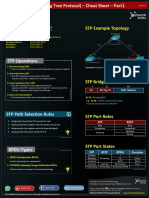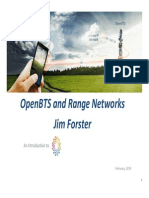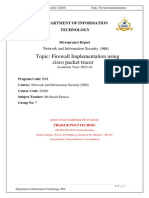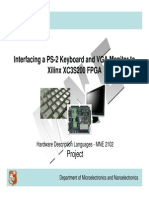0 ratings0% found this document useful (0 votes)
41 viewsLecture 2
Lecture 2
Uploaded by
Sumaia PrantiThe document discusses circuit switching and packet switching in computer networks. Circuit switching reserves resources along a communication path for the duration of a session, while packet switching allows resources to be used on demand, potentially resulting in queueing delays. Traditional telephone networks use circuit switching, while the Internet uses packet switching. The document also describes types of delays that can occur in packet-switched networks, including processing, queuing, transmission, and propagation delays.
Copyright:
© All Rights Reserved
Available Formats
Download as PDF, TXT or read online from Scribd
Lecture 2
Lecture 2
Uploaded by
Sumaia Pranti0 ratings0% found this document useful (0 votes)
41 views30 pagesThe document discusses circuit switching and packet switching in computer networks. Circuit switching reserves resources along a communication path for the duration of a session, while packet switching allows resources to be used on demand, potentially resulting in queueing delays. Traditional telephone networks use circuit switching, while the Internet uses packet switching. The document also describes types of delays that can occur in packet-switched networks, including processing, queuing, transmission, and propagation delays.
Original Description:
Computer Network
Copyright
© © All Rights Reserved
Available Formats
PDF, TXT or read online from Scribd
Share this document
Did you find this document useful?
Is this content inappropriate?
The document discusses circuit switching and packet switching in computer networks. Circuit switching reserves resources along a communication path for the duration of a session, while packet switching allows resources to be used on demand, potentially resulting in queueing delays. Traditional telephone networks use circuit switching, while the Internet uses packet switching. The document also describes types of delays that can occur in packet-switched networks, including processing, queuing, transmission, and propagation delays.
Copyright:
© All Rights Reserved
Available Formats
Download as PDF, TXT or read online from Scribd
Download as pdf or txt
0 ratings0% found this document useful (0 votes)
41 views30 pagesLecture 2
Lecture 2
Uploaded by
Sumaia PrantiThe document discusses circuit switching and packet switching in computer networks. Circuit switching reserves resources along a communication path for the duration of a session, while packet switching allows resources to be used on demand, potentially resulting in queueing delays. Traditional telephone networks use circuit switching, while the Internet uses packet switching. The document also describes types of delays that can occur in packet-switched networks, including processing, queuing, transmission, and propagation delays.
Copyright:
© All Rights Reserved
Available Formats
Download as PDF, TXT or read online from Scribd
Download as pdf or txt
You are on page 1of 30
Computer Networks
Lecture 2
Shamim Ahmed, Lecturer, Dept. of CSE,
10/19/2014 1
BUBT, Dhaka
Circuit Switching and Packet
Switching
• There are two fundamental approaches to
moving data through a network of links and
switches:
– circuit switching and
– packet switching.
Shamim Ahmed, Lecturer, Dept. of CSE,
10/19/2014 2
BUBT, Dhaka
Circuit Switching and Packet
Switching
• In circuit-switched networks, the resources
needed along a path (buffers, link transmission
rate) to provide for communication between the
end systems are reserved for the duration of the
communication session between the end systems.
• In packet-switched networks, these resources
are not reserved; a session’s messages use the
resources on demand, and as a consequence,
may have to wait (that is, queue) for access to a
communication link.
Shamim Ahmed, Lecturer, Dept. of CSE,
10/19/2014 3
BUBT, Dhaka
Circuit Switching and Packet
Switching
• Traditional telephone networks are examples of circuit-
switched networks.
• Consider what happens when one person wants to send
information (voice or facsimile) to another over a telephone
network. Before the sender can send the information, the
network must establish a connection between the sender and
the receiver. This connection is called a circuit. When the
network
• establishes the circuit, it also reserves a constant transmission
rate in the network’s links (representing a fraction of each
link’s transmission capacity) for the duration of the
connection.
Shamim Ahmed, Lecturer, Dept. of CSE,
10/19/2014 4
BUBT, Dhaka
Multiplexing in Circuit-Switched
Networks
• A circuit in a link is implemented with either-
• Frequency-division multiplexing(FDM) or
• Time-division multiplexing (TDM).
Shamim Ahmed, Lecturer, Dept. of CSE,
10/19/2014 5
BUBT, Dhaka
Frequency-division multiplexing(FDM)
• With FDM, the frequency spectrum of a link is divided
up among the connections established across the link.
• Specifically, the link dedicates a frequency band to
each connection for the duration of the connection.
• In telephone networks, this frequency band typically
has a width of 4 kHz (that is, 4,000 hertz or 4,000 cycles
per second). The width of the band is called, not
surprisingly, the bandwidth.
• FM radio stations also use FDM to share the frequency
spectrum between 88 MHz and 108 MHz, with each
station being allocated a specific frequency band.
Shamim Ahmed, Lecturer, Dept. of CSE,
10/19/2014 6
BUBT, Dhaka
Time-division multiplexing (TDM)
• For a TDM link, time is divided into frames of
fixed duration, and each frame is divided into a
fixed number of time slots.
• When the network establishes a connection
across a link, the network dedicates one time slot
in every frame to this connection.
• These slots are dedicated for the sole use of that
connection, with one time slot available for use
(in every frame) to transmit the connection’s
data.
Shamim Ahmed, Lecturer, Dept. of CSE,
10/19/2014 7
BUBT, Dhaka
Shamim Ahmed, Lecturer, Dept. of CSE,
10/19/2014 8
BUBT, Dhaka
Packet Switching Versus Circuit
Switching
• Packet switching is not suitable for real-time
services (for example, telephone calls and video
conference calls) because of its variable and
unpredictable end-to-end delays (due primarily to
variable and unpredictable queuing delays).
• It offers better sharing of transmission capacity
than circuit switching.
• It is simpler, more efficient, and less costly to
implement than circuit switching.
• Generally speaking, people who do not like to
hassle with restaurant reservations prefer packet
switching to circuit switching.
Shamim Ahmed, Lecturer, Dept. of CSE,
10/19/2014 9
BUBT, Dhaka
Packet Switching Versus Circuit
Switching
• The performance of packet switching can be
superior to that of circuit switching.
• In Circuit switching pre-allocates use of the
transmission link regardless of demand, with
allocated but unneeded link time going
unused. Packet switching on the other hand
allocates link use on demand.
Shamim Ahmed, Lecturer, Dept. of CSE,
10/19/2014 10
BUBT, Dhaka
Delay in Packet-Switched Networks
• Recall that a packet starts in a host (the
source), passes through a series of routers,
and ends its journey in another host (the
destination).
• As a packet travels from one node (host or
router) to the subsequent node (host or
router) along this path, the packet suffers
from several types of delays at each node
along the path.
Shamim Ahmed, Lecturer, Dept. of CSE,
10/19/2014 11
BUBT, Dhaka
Delay in Packet-Switched Networks
• The most important of these delays are –
• The nodal processing delay
• Queuing delay
• Transmission delay and
• Propagation delay.
• Together these delays accumulate to give a
total nodal delay.
Shamim Ahmed, Lecturer, Dept. of CSE,
10/19/2014 12
BUBT, Dhaka
Delay in Packet-Switched Networks
• The performance of many Internet applications—such
as search, Web browsing, email, maps, instant
messaging, and voice-over-IP—are greatly affected by
network delays.
Shamim Ahmed, Lecturer, Dept. of CSE,
10/19/2014 13
BUBT, Dhaka
Processing Delay
• The time required to examine the packet’s header
and determine where to direct the packet is part
of the processing delay.
• The processing delay can also include other
factors, such as the time needed to check for bit-
level errors in the packet that occurred in
transmitting the packet’s bits from the upstream
node to router A.
• Processing delays in high-speed routers are
typically on the order of microseconds or less.
• After this nodal processing, the router directs the
packet to the queue that precedes the link to
router B.
Shamim Ahmed, Lecturer, Dept. of CSE,
10/19/2014 14
BUBT, Dhaka
Queuing Delay
• At the queue, the packet experiences a queuing delay
as it waits to be transmitted onto the link.
• The length of the queuing delay of a specific packet will
depend on the number of earlier-arriving packets that
are queued and waiting for transmission onto the link.
• If the queue is empty and no other packet is currently
being transmitted, then our packet’s queuing delay will
be zero.
• On the other hand, if the traffic is heavy and many
other packets are also waiting to be transmitted, the
queuing delay will be long.
• Queuing delays can be on the order of microseconds to
milliseconds in practice.
Shamim Ahmed, Lecturer, Dept. of CSE,
10/19/2014 15
BUBT, Dhaka
Transmission Delay
• Assuming that packets are transmitted in a first-come-
first-served manner, as is common in packet-switched
networks, our packet can be transmitted only after all
the packets that have arrived before it have been
transmitted.
• Denote the length of the packet by L bits, and denote
the transmission rate of the link from router A to router
B by R bits/sec. For example, for a 10 Mbps Ethernet
link, the rate is R = 10 Mbps; for a 100 Mbps Ethernet
link, the rate is R = 100 Mbps. The transmission delay
is L/R.
• Transmission delays are typically on the order of
microseconds to milliseconds in practice.
Shamim Ahmed, Lecturer, Dept. of CSE,
10/19/2014 16
BUBT, Dhaka
Propagation Delay
• Once a bit is pushed into the link, it needs to
propagate to router B. The time required to
propagate from the beginning of the link to
router B is the propagation delay.
• The bit propagates at the propagation speed
of the link.
• The propagation speed depends on the
physical medium of the link (that is, fiber
optics, twisted-pair copper wire, and so on).
Shamim Ahmed, Lecturer, Dept. of CSE,
10/19/2014 17
BUBT, Dhaka
Total nodal delay
• If we let dproc, dqueue, dtrans, and dprop denote the
processing, queuing, transmission, and
propagation delays.
• Then the total nodal delay is given by-
dnodal = dproc + dqueue + dtrans + dprop
Shamim Ahmed, Lecturer, Dept. of CSE,
10/19/2014 18
BUBT, Dhaka
Packet Loss
• A packet can arrive to find a full queue. With
no place to store such a packet, a router will
drop that packet; that is, the packet will be
lost.
• From an end-system viewpoint, a packet loss
will look like a packet having been transmitted
into the network core but never emerging
from the network at the destination.
Shamim Ahmed, Lecturer, Dept. of CSE,
10/19/2014 19
BUBT, Dhaka
End-to-End Delay
• Suppose there are N 1 routers between the
source host and the destination host.
• The queuing delays are negligible.
• The processing delay at each router and at the
source host is dproc,
• The transmission rate out of each router and out
of the source host is R bits/sec, and the
propagation on each link is dprop. The nodal delays
accumulate and give an end-to-end delay:
dend-end = N (dproc + dtrans + dprop)
Shamim Ahmed, Lecturer, Dept. of CSE,
10/19/2014 20
BUBT, Dhaka
Throughput in Computer Networks
• Let Rs denote the rate of the link between the
server and the router; and
• Rc denote the rate of the link between the router
and the client.
Shamim Ahmed, Lecturer, Dept. of CSE,
10/19/2014 21
BUBT, Dhaka
Throughput in Computer Networks
• The server cannot pump bits through its link at a
rate faster than Rs bps; and the route cannot
forward bits at a rate faster than Rc bps.
• If Rs < Rc, then the bits pumped by the server will
“flow” right through the router and arrive at the
client at a rate of Rs bps, giving a throughput of Rs
bps.
• If, on the other hand, Rc < Rs, then the router will
not be able to forward bits as quickly as it
receives them. In this case, bits will only leave the
router at rate Rc, giving an end-to-end throughput
of Rc.
Shamim Ahmed, Lecturer, Dept. of CSE,
10/19/2014 22
BUBT, Dhaka
Shamim Ahmed, Lecturer, Dept. of CSE,
10/19/2014 23
BUBT, Dhaka
Layered Architecture
Shamim Ahmed, Lecturer, Dept. of CSE,
10/19/2014 24
BUBT, Dhaka
Layered Architecture
Shamim Ahmed, Lecturer, Dept. of CSE,
10/19/2014 25
BUBT, Dhaka
Layered Architecture
Shamim Ahmed, Lecturer, Dept. of CSE,
10/19/2014 26
BUBT, Dhaka
Encapsulation
Shamim Ahmed, Lecturer, Dept. of CSE,
10/19/2014 27
BUBT, Dhaka
Encapsulation
• At the sending host, an application-layer message (M)
is passed to the transport layer.
• The transport layer takes the message and appends
additional information (so-called transport-layer
header information, Ht) that will be used by the
receiver-side transport layer.
• The application layer message and the transport-layer
header information together constitute the transport-
layer segment.
• The transport layer then passes the segment to the
network layer, which adds network-layer header
information (Hn) such as source and destination end
system addresses, creating a network-layer datagram.
Shamim Ahmed, Lecturer, Dept. of CSE,
10/19/2014 28
BUBT, Dhaka
Encapsulation
• The datagram is then passed to the link layer,
which will add its own link-layer header
information and create a link-layer frame.
• A packet has two types of fields: header fields
and a payload field. The payload is typically a
packet from the layer above.
Shamim Ahmed, Lecturer, Dept. of CSE,
10/19/2014 29
BUBT, Dhaka
End
Shamim Ahmed, Lecturer, Dept. of CSE,
10/19/2014 30
BUBT, Dhaka
You might also like
- Exam JN0-363: Service Provider Routing and Switching, Specialist (JNCIS-SP)Document43 pagesExam JN0-363: Service Provider Routing and Switching, Specialist (JNCIS-SP)Sehar100% (1)
- Seo Audit-ReportDocument27 pagesSeo Audit-ReportjrhitmanNo ratings yet
- How To Hack WPA WPA2 WiFi Using Kali Linux - TelegDocument7 pagesHow To Hack WPA WPA2 WiFi Using Kali Linux - TelegSridhar PNo ratings yet
- MTCNA Lab Guide INTRA 1st Edition - Id.en PDFDocument87 pagesMTCNA Lab Guide INTRA 1st Edition - Id.en PDFreyandyNo ratings yet
- LAN Management QuestionnaireDocument6 pagesLAN Management QuestionnaireraducreangaNo ratings yet
- SwitchingDocument28 pagesSwitchingSOURAVNo ratings yet
- Switching TechniquesDocument18 pagesSwitching Techniquesjnike9890No ratings yet
- Switching TechniquesDocument18 pagesSwitching Techniquesdeepank singhNo ratings yet
- Switching SystemDocument49 pagesSwitching SystemjansarveshNo ratings yet
- Switching TechniquesDocument45 pagesSwitching TechniquesFarzeen FatimaNo ratings yet
- Switching TechniqueDocument13 pagesSwitching Techniquemahendhrannaveen384No ratings yet
- 145fer Cis85 CI Lect6 ISISDocument82 pages145fer Cis85 CI Lect6 ISISFerdy GozalNo ratings yet
- Diploma in Smartphone EngineringDocument2 pagesDiploma in Smartphone EngineringsthattasserilNo ratings yet
- Presentation 4922 1510103908Document24 pagesPresentation 4922 1510103908mohammed almadanyNo ratings yet
- FirewallsDocument35 pagesFirewallsJawaNo ratings yet
- Firewalls: CS 772 Fall 2009Document19 pagesFirewalls: CS 772 Fall 2009XozanNo ratings yet
- How To Deploy A Next - Js Application To A VPSDocument21 pagesHow To Deploy A Next - Js Application To A VPSdiekola ridwanNo ratings yet
- Ccnasecurity Sba FinalDocument12 pagesCcnasecurity Sba FinalBilly Zomg100% (2)
- Mikrotik in Real Life, Full Scale and Low Budget ISP PDFDocument44 pagesMikrotik in Real Life, Full Scale and Low Budget ISP PDFNay Lin KyawNo ratings yet
- Is-Is Routing ProtocolDocument27 pagesIs-Is Routing Protocolkukulkan9No ratings yet
- IPCisco Cisco Juniper Alcatel Nokia Huawei CheatSheet PDFDocument9 pagesIPCisco Cisco Juniper Alcatel Nokia Huawei CheatSheet PDFRon BerserkirNo ratings yet
- As A Command Line Technical GuideDocument35 pagesAs A Command Line Technical GuideVijayVigneshNo ratings yet
- Mobile Repairing Course Institute - Mobile Repairing Course Institute Delhi, IndiaDocument4 pagesMobile Repairing Course Institute - Mobile Repairing Course Institute Delhi, IndiaRishabh RastogiNo ratings yet
- UBRDocument20 pagesUBRSushil MannNo ratings yet
- Routing Introduction in BGPDocument48 pagesRouting Introduction in BGPChazzy CanjaNo ratings yet
- Nokia 300 Asha RM-781 Schematics v1.0Document7 pagesNokia 300 Asha RM-781 Schematics v1.0Noureddine TakouchtNo ratings yet
- ASA FirewalldesignDocument118 pagesASA FirewalldesignSatya VasuNo ratings yet
- List of PortsDocument60 pagesList of PortsDaniel TinevNo ratings yet
- What Is SDH (Synchronous Digital Hierarchy) : Quick ContactDocument10 pagesWhat Is SDH (Synchronous Digital Hierarchy) : Quick Contactiimran_ahmdNo ratings yet
- Gns 3Document30 pagesGns 3Yulia VironicaNo ratings yet
- Mtcna 05 2012Document398 pagesMtcna 05 2012wahyuningastuti_82No ratings yet
- STP Notes Part 1 Cheat Sheet Network WalksDocument1 pageSTP Notes Part 1 Cheat Sheet Network WalksMohammad AkberNo ratings yet
- Multiple Spanning Tree ProtocolDocument7 pagesMultiple Spanning Tree ProtocolPadam DhamiNo ratings yet
- MPLS P62Document40 pagesMPLS P62josue samaniegoNo ratings yet
- Hardware and Networking Notes by Jafar Shaikh COCSITDocument101 pagesHardware and Networking Notes by Jafar Shaikh COCSITJafar Shaikh100% (1)
- Green Chip: Institute of Advanced TechnologyDocument3 pagesGreen Chip: Institute of Advanced TechnologyMathewsNo ratings yet
- High Availability On MikroTik RouterOS PDFDocument29 pagesHigh Availability On MikroTik RouterOS PDFrami aliNo ratings yet
- Puter NetworksDocument28 pagesPuter Networkswaleed.khaldNo ratings yet
- Cdot EngiDocument57 pagesCdot EngiNAMANI SRAVAN KUMARNo ratings yet
- 10.2.1.9 Lab - Configure A Site-to-Site IPsec VPN Using ISR CLI and ASA 5505 ASDMDocument22 pages10.2.1.9 Lab - Configure A Site-to-Site IPsec VPN Using ISR CLI and ASA 5505 ASDMelizaNo ratings yet
- Mobile Hardware ArchitectureDocument20 pagesMobile Hardware ArchitectureSk. Azraf SamiNo ratings yet
- Bluetooth SDP ProtocolDocument72 pagesBluetooth SDP ProtocolGuru KandhanNo ratings yet
- C - DOT Exchange Control Department of Telematics (C-DOT) Exchange Was DesignedDocument11 pagesC - DOT Exchange Control Department of Telematics (C-DOT) Exchange Was Designedkhadarbasha.n nNo ratings yet
- How Cable Modems WorkDocument6 pagesHow Cable Modems WorkboyetcincoNo ratings yet
- OFDM Modulation and DemodulationDocument25 pagesOFDM Modulation and DemodulationAparna MishraNo ratings yet
- Open BTS - Jim FosterDocument22 pagesOpen BTS - Jim FosterholidyrasyidNo ratings yet
- Ethernet Protocol PDFDocument2 pagesEthernet Protocol PDFBrittany0% (1)
- Ethical HackingDocument27 pagesEthical HackingRichi MonaniNo ratings yet
- Mikrotik MPLSDocument23 pagesMikrotik MPLSinnovativekaluNo ratings yet
- IC TesterDocument2 pagesIC TestervaibhavgijareNo ratings yet
- OSI Model For Data Communication: Er. Avinash Bhagat 9463281930Document49 pagesOSI Model For Data Communication: Er. Avinash Bhagat 9463281930sami ahmadiNo ratings yet
- Configuration Guide - MPLS (V200R001C00 - 01)Document494 pagesConfiguration Guide - MPLS (V200R001C00 - 01)Vladan ColakovicNo ratings yet
- Smartplus 2012.02.16 BSFDocument18 pagesSmartplus 2012.02.16 BSFAnusuya Rawat100% (1)
- NetworksDocument20 pagesNetworksshivam100% (1)
- Nokia C2-05 RM-724 725 Service ManualDocument0 pagesNokia C2-05 RM-724 725 Service ManualJesus Alfonso Blanchard CeledonNo ratings yet
- Configuring Clocking and TimingDocument52 pagesConfiguring Clocking and Timingreza_azadNo ratings yet
- Database System: 1. DataDocument5 pagesDatabase System: 1. DatajnNo ratings yet
- eMMC Device Register Linux Kernel InternalsDocument5 pageseMMC Device Register Linux Kernel InternalsSiba SsmNo ratings yet
- Understanding UMTS Radio Network Modelling, Planning and Automated Optimisation: Theory and PracticeFrom EverandUnderstanding UMTS Radio Network Modelling, Planning and Automated Optimisation: Theory and PracticeMaciej NawrockiNo ratings yet
- TB250-BTC Pro - 20181018Document6 pagesTB250-BTC Pro - 20181018apadonkyangbelumadaNo ratings yet
- Supplement D: Waiting Line ModelsDocument33 pagesSupplement D: Waiting Line ModelsSabir AliNo ratings yet
- Substation Automation and SCADA ProtocolsDocument6 pagesSubstation Automation and SCADA ProtocolsDrAshok Kumar TiwariNo ratings yet
- Datasheet DSX-8000 CableAnalyzerT SeriesDocument15 pagesDatasheet DSX-8000 CableAnalyzerT SeriesHendro SuryonoNo ratings yet
- Huawei LTE SolutionDocument4 pagesHuawei LTE SolutionSabrine ChahbiNo ratings yet
- Lec - MAC Protocols For Ad Hoc Wireless Networks - ppt13!11!17Document18 pagesLec - MAC Protocols For Ad Hoc Wireless Networks - ppt13!11!17raham niaziNo ratings yet
- Conference AINADocument11 pagesConference AINAJalel Eddine HajlaouiNo ratings yet
- Topic: Firewall Implementation Using Cisco Packet Tracer: Department of Information TechnologyDocument15 pagesTopic: Firewall Implementation Using Cisco Packet Tracer: Department of Information Technologyvsslondhe13No ratings yet
- PS2 Keyboard and VGA OutputDocument14 pagesPS2 Keyboard and VGA OutputAbdul JabbarNo ratings yet
- IIT Project Report On Modulation New MainDocument32 pagesIIT Project Report On Modulation New MainPreet ChahalNo ratings yet
- Everquest Emu Setup PDFDocument2 pagesEverquest Emu Setup PDFJonNo ratings yet
- 5.1.2.6 Packet Tracer - Configure Wireless SecurityDocument3 pages5.1.2.6 Packet Tracer - Configure Wireless SecurityCarlos Sulca NeiraNo ratings yet
- Hospitality Information Systems: Cabi Tourism Texts Cabi Tourism TextsDocument20 pagesHospitality Information Systems: Cabi Tourism Texts Cabi Tourism TextsCristy Lansangan MejiaNo ratings yet
- Gmail 1Document3 pagesGmail 1Yamato Rios MendozaNo ratings yet
- 6MD66xx Manual PIXIT A5 V047100 en PDFDocument110 pages6MD66xx Manual PIXIT A5 V047100 en PDFPiero David Guerrero BernalNo ratings yet
- Deep Mesh Network BrochureDocument4 pagesDeep Mesh Network BrochureWín Bolotano De GuzmanNo ratings yet
- Isro Paper CsDocument12 pagesIsro Paper CsArvind SinghNo ratings yet
- Brkccie 3203Document93 pagesBrkccie 3203alfagemeoNo ratings yet
- M1000 Prov2 in Meter ReadingDocument3 pagesM1000 Prov2 in Meter ReadingGunawan WibisonoNo ratings yet
- Simulasi Jaringan Berbasis Komputer: Network Traffic ModelingDocument34 pagesSimulasi Jaringan Berbasis Komputer: Network Traffic ModelingMalik PurwokoNo ratings yet
- About Switches Data SheetDocument3 pagesAbout Switches Data SheetGopi ChowdaryNo ratings yet
- Glosario MitelDocument53 pagesGlosario Miteleduardo perezNo ratings yet
- GPS DCS Time SyhchronisationDocument6 pagesGPS DCS Time Syhchronisationkoushik42000No ratings yet
- Color Control GX Manual (Victron Energy)Document44 pagesColor Control GX Manual (Victron Energy)Javier Moreno PonsNo ratings yet
- Q2 2021 Fundamental IT Engineer Examination (Afternoon)Document40 pagesQ2 2021 Fundamental IT Engineer Examination (Afternoon)Pham Tien ThanhNo ratings yet
- Test Chapter 11Document15 pagesTest Chapter 11Rildo Reis TanNo ratings yet

























































































